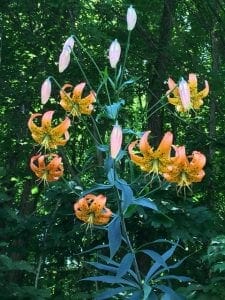

Scientific name: Lilium superbum
Common name: Turk’s-cap lily
Family: Liliaceae
Plant type: Perennial
In early summer a single Turk’s-cap lily (Lilium superbum) can produce a full bouquet of a dozen or more (up to 40) flowers at a time. Each nodding bloom measures 5-8” across and features 6 orange tepals (petals and petal-like sepals) that curve back reflexively to almost touch the stem. The flowers are speckled with maroon spots. Six long, yellow stamens with brownish anthers protrude well beyond the tepals. A green “star” streaked inside the center of each bloom is a hallmark of the species and distinguishes it from similar plants. Turk’s-cap is the tallest of the North American lilies, typically reaching 4-6’ in height (it can grow to 8’ under optimal conditions). Long, narrow dark green leaves grow in whorls around straight stems that branch near the top. Flowers are located at the branch termini. The species was named Turk’s-cap because of its resemblance to the Eurasian Turk’s cap lily (Lilium martagon). Martagon means “turban” or “Turk’s cap”, and refers to the flower shape. Turk’s-cap lily can be found on sunny stream banks, wetland meadows, and forest edges. It thrives in the sun, but doesn’t like to be dried out, preferring moist, well-drained soils. It will spread when happy, thanks to rhizomatous bulbs. These bulbs are edible when cooked, and supposedly taste like turnips. Just don’t feed them to your cat. All plant parts are toxic to felines.
Credits: Text by Valerie Boss. Photos by Ellen Honeycutt (left) and Debby Meadows (right).
